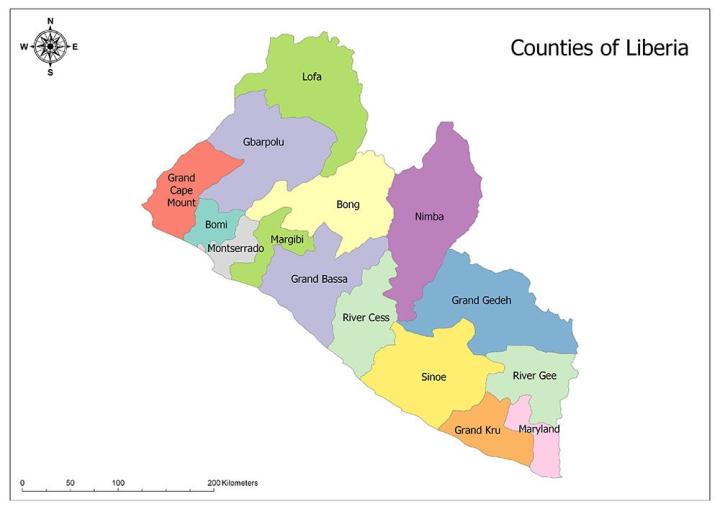The Accelerated Community Development Programme
Project Summary
The economic growth and development potential of Africa’s first independent republic has always been stifled by historically entrenched inequities, ranging from access to opportunities between genders and urban and rural areas to widespread infrastructure deficits, and pervasive poverty. These inequalities have undermined and hindered the growth potential of individuals, communities, and the country.

In 2020, the Liberian government (GoL) and the United Nations Development Program (UNDP) commissioned a feasibility study to understand and propose a new approach to development.
The Accelerated Community Development Programme was born as a result, representing a new approach rooted in the local industrial development model, which has been identified as the most effective strategy to promote local community-based development. The ACDP is a five-year ambitious flagship program of the Liberian government being implemented by the UNDP in collaboration with key line government ministries and agencies. It seeks to mobilize funding from government and development partners. This model has been implemented in several countries including Senegal, Togo, The Gambia, and Congo, proven to be results-oriented, according to UNDP. The ACDP has enabled African countries to boost their rural economies (increase in productivity and agro-pastoral production, development of rural entrepreneurship increased rural household income), developed basic social economic infrastructure (water, electricity, feeder roads, health, education, housing) using local workforce thereby providing employment, provided modern equipment, and rural development services, infrastructure connecting agriculture and livestock basins to markets.
Objective
The overall goal of the ACDP is to meet the real needs of the most vulnerable rural populations, having an immediate effect on poverty reduction while accelerating the socio-economic development of rural communities. It will also assist in strengthening human capital and resilience to shocks and pandemics; catalyzing implementation of the national pro-poor poverty agenda; reducing inequality between the urban and rural areas; improving access to basic social and economic infrastructure; and creating short- and long-term jobs.
Expected Results
Reduce spatial (territorial) inequalities and transform the living conditions and living environment of Liberians living in areas with little or no access to basic social and economic infrastructure and services.
Targeted interventions for poor rural areas and those poorly served in social and economic infrastructure and its integrated offer of services- water, electricity, affordable and clean energy, rural roads, health, education, housing, and agricultural processing equipment, tools, accountability, and community-led inclusive governance systems.
Significantly improving conditions for residents of targeted rural and urban communities through environmentally sustainable and equitable access to basic water, sanitation, and Hygiene (WASH) services by 2025.
By 2025, early impact infrastructure investments create multiplier effects on access to markets, agriculture, fishery production, and other economic activities in targeted rural communities.
A sustainable and inclusive model for a multi-sectorial approach to fast-track rural infrastructure development successfully piloted—with particular emphasis on providing equitable access to opportunities for women and girls.
Strengthened capacity for private and public sector players to increase economic participation and rural productivity, enabling employment, job creation, and enterprise development.
Achievements
A feasibility study was conducted, and a high-level meeting was held followed by several scoping missions that culminated in the preparation and endorsement of the ACDP Programme Document.
Delivered farm tractors, and other agricultural equipment and tools to the Government of Liberia and selected communities in Bomi, Bong, Gbarpolu, Lofa, Nimba, and Rivercess. 41 sets of post-harvest processing machines were delivered to 14 agricultural cooperatives. These include rice mills, cassava mills, sugar cane mills, and rice threshers to improve the quality of the farm produce and aid with the transportation of produce from the farm to the post-harvest processing machine facilities and the market. Over 2,400 individual farmers benefitted from the farming implements to support individual farming activities.
Tractor operator training was conducted in Bong and Gbarpolu counties for 28 participants from 14 agricultural cooperatives and trained 148 members (75 men and 73 women) of the 14 selected agricultural cooperatives across the six counties in pre-cooperative formation, good governance, and financial management in keeping with the Cooperative Development Agency’s (CDA) standards in Liberia.
Disbursed first tranche start-up grant of $USD 10,000.00 to each of the initial 10 selected agricultural cooperatives to aid with the early-stage development and day-to-day operations. The second tranche of the grants ($10K to each) will be disbursed in March 2024, amounting to $200K for the initial 10 selected cooperatives.
Distributed 4,098KG, improved rice seeds, (326KG) beans seeds, and 73KG maize seeds to farming communities targeted under the project.
Drilled five (5) boreholes across Bong, Gbarpolu, and Rivercess counties and constructed 5 water towers, equipped with chlorination units for purification of water and solar energy to pump water from the boreholes to the reservoirs.
Erected giant-sized billboards in Project locations/communities with messages about the project’s interventions, produced and aired radio jingles on rural community radio stations about the ADCP interventions, and printed and distributed ACDP branded materials.
Quick Facts
| Duration | November 2022 to November 2027 |
| Budget/Investment | US$ 100million |
| Donors | Government of Liberia, UNDP, (World Bank-$6m, African Development Bank $5m) |
| Implementing Partners | Ministries of State, Internal Affairs, Finance and Development Planning, Education, Public Works, and Health |
| Coverage | National (Six Counties) |
| Targeted Beneficiaries | Rural Communities in six counties |
| Focus Area/SDG | Inclusive Governance/SDGs 1, & 16 |

 Locations
Locations